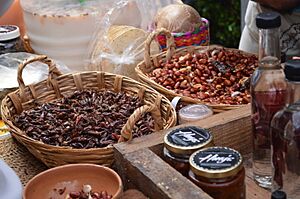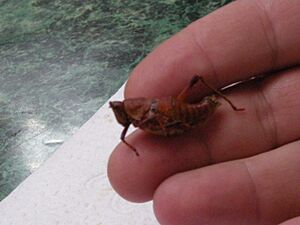Chapulines facts for kids
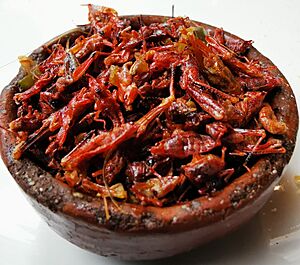
Chapulines are a type of grasshopper that people commonly eat in certain parts of Mexico. The word "chapulín" comes from the Nahuatl language, which was spoken by the Aztec people.
People collect these grasshoppers only at certain times of the year. This is usually from when they hatch in early May until late summer or early autumn. After they are collected, they are often toasted on a special flat griddle called a comal. They are usually seasoned with tasty ingredients like garlic, lime juice, chilies, or salt.
One of the main places where chapulines are eaten is Oaxaca, a state in Mexico. Here, you can find them sold as snacks at local sports events. They are also becoming popular again among people who love trying new foods. Records from the 16th century, during the Spanish conquest, even mention grasshoppers being eaten.
Besides Oaxaca, chapulines are also popular near Mexico City. You can find them in towns like Tepoztlán, Cuernavaca, and Puebla. People might eat them by themselves as a snack, called a botana. Or, they can be used as a filling in other dishes, like a tlayuda (a large, crispy tortilla) filled with chapulines. In 2017, the Seattle Mariners baseball team even offered chapulines as a unique snack at their home games!
Are Chapulines Safe to Eat?
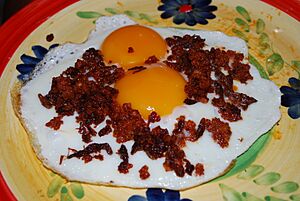
In 2007, some news reports in America raised concerns about chapulines imported from a town in Oaxaca. These concerns were about possible lead contamination in some of the products.
It's also important to know that if you are allergic to shellfish like shrimp or crab, you might also be allergic to edible insects. This is because insects and shellfish are related and have similar body chemistry.
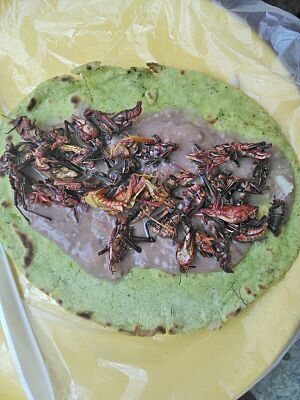
Some contaminated chapulines were found for sale in California. These were traced back to samples from the same area in Oaxaca.
See Also
 In Spanish: Chapulín para niños
In Spanish: Chapulín para niños
- Entomophagy (the practice of eating insects)
- Entomophagy in humans
- Insects as food
- List of edible insects by country
- List of Mexican dishes
- List of Spanish words of Nahuatl origin
- Chapulín de la milpa (Sphenarium purpurascens), a specific type of grasshopper found in Mexico and Guatemala


